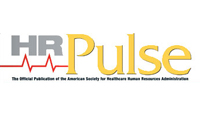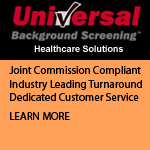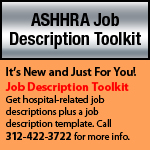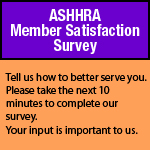| January 12, 2011 | Printer Friendly Version | Advertise | Join ASHHRA | ||

|
PRESIDENT'S MESSAGE
Dear ASHHRA Members, GETTING TO KNOW YOU, GETTING TO KNOW ME Happy New Year! My wish to you for 2011, is to remain healthy, employed, and challenged in your work! I want to start the year with some encouragement. If you have gotten to know me, you may have heard me mention this before, but ASHHRA needs your voice. Your participation in making our organization "Great to Greater" is what I’d like to see continuously throughout the new year and beyond, and into this "era of change." So, how can you help us, you ask? The simplest form of involvement is giving us your feedback. HR people are generally not shy about doing so. If there is something you’d like to see improved or implemented, please let me, or any of your 2011 ASHHRA Board, or Stephanie Drake and the ASHHRA staff know what’s on your mind. We are here to serve. On a higher level, get involved with a committee or volunteer for a board assignment when the nomination process begins. I have always said there are those who "do" and those who watch others "do." Be a "doer"! This is your organization and if you want to make it "greater," be a "doer." We welcome you! In my HR role and as a leader my emphasis to those who have worked with me has always been two-fold, teamwork and customer service. Without it, we are less than effective. My promise to you for 2011 is that our board, your leadership team, will strive to provide the highest level of customer service and aspire to be the best team ever. We have some significant goals for this year, in conjunction with our strategic plan, and are ready to take them on aggressively. In order for you to know me a little better, on the Gallup Strengths Finder assessment, my strengths in leadership are Arranger, WOO, Maximizer, Strategic, and Relator. On the Myers Briggs, I am an ENFP. That will tell you volumes about me! I look forward to meeting many more of you and getting to know you throughout the year. In closing, I would like to thank 2010 President Jeff Payne for his outstanding leadership and guidance. In addition, I offer great respect and admiration for the 2010 Board of Directors and the tremendous work that was accomplished in a year of turbulent economics. We are much stronger for that effort. For those departing our Board, Past President Dan Zuhlke, Bob Morrison, Jim Frain, and my fellow "Blues Brother" Barry Lindeman, I salute you and will cherish your leadership and friendship. Again, this organization is much stronger because of you! To Stephanie and the ASHHRA staff, you worked miracles in 2010 and I thank you. I look forward to working with you for an even more successful 2011! Robert Walters, SPHR ASHHRA NEWS
LEGAL
WORKFORCE
COMPENSATION
GENERAL HR
BENEFITS
PHYSICIANS
MANAGEMENT & LEADERSHIP
LEGAL
WORKFORCE
It goes without saying that without good, qualified employees, you cannot serve your patients, their families, and the community. Hiring the right people and engaging and retaining your employees will result in higher morale, lower employee turnover, and a much stronger bottom line. As we face global unprecedented demographic, economic, and competitive challenges, and other industries experience layoffs and cutbacks, most analysts have projected that the health care industry will be the fastest-growing segment of the economy over the next ten years and will account for at least three out of every 10 new jobs created. Developing an effective talent acquisition strategy is a challenge, especially within the health care industry as the shortage of health care professionals grows. Unfortunately, there is no industry that is more archaic in recruiting and talent management than health care. The approach and overall attitude found in many health care recruiting functions is often antiquated. This assessment is based upon my 21 years of observation and experience working with a number of health care organizations and professionals within in the USA and globally to improve the impact of their recruiting and retention efforts. Not all health care organizations are awful at recruiting; those who have mastered 21st century recruiting approaches achieve phenomenal success. Unfortunately, the vast majority (90 percent) seem as dedicated to generating excuses for their shortcomings as the leading 10 percent is to making a difference. In health care, the ability to quickly screen, hire, and onboard medical personnel can have a direct affect on patients' well-being. As such, recruitment and retention in the health care industry must remain a top priority. By many estimates, the number of Americans nearing retirement will increase by more than 30 percent, while the population of young adults entering the workforce will rise by less than 3 percent. The need for health care organizations to make talent management a top priority is further emphasized by the pending talent crisis and the need to hire and retain key employees when we consider this fact and the other challenges such as a growing number of current workers leaving the field and more stringent budget cuts, the likelihood of increased governmental regulation and global competition. Talent Management Accountability involves four key areas: Attracting the Right Employees Competition for a shrinking talent pool is keen. Potential health care employees have more choices of where to work. Globalization makes skilled workers prime recruiting targets of health care organizations around the world, and the Internet makes it simple for health care employees to find and compare job opportunities. Finding prospective employees is the first step. Finding the right employees from among the prospects is the second. And then quickly getting the right employees geared up, motivated, productive, and confident in their new responsibilities is the third. Whose job is it to source? To interview? To hire? To orient and train new employees? Health care Organizations of all sizes implement a variety of new processes and procedures—usually through their human resources departments—to make sourcing, hiring, and onboarding more effective. Technology, for example, plays an ever-bigger role in many organizations. Facilities can now implement software applications that initiate a requisition to staffing, post jobs to job boards and corporate websites, extract resumes to databases, track candidates through prescreening and reference checking, schedule interviews, stay in e-mail contact with candidates, and make employment offers. Many organizations also design and implement standardized job descriptions, interview guides, reference checking procedures, outsourced recruiting assistance, and other processes to help their hiring managers reach the job offer and acceptance stage. Then, retooled employee orientation, training, and mentoring programs help get new employees up to speed quickly. In these ways, HR adds real value to the process, freeing managers to focus on their day-to-day operational issues. But these value-added tools and techniques can backfire when managers rely too heavily on them to bring new people into the organization or when they take the "it’s HR’s job" approach to this key accountability. Unit managers always have been and must continue to be ultimately responsible for attracting new employees to the health care organization. They know the job that needs to be done, they know the culture, they know the team dynamics, they know the results that both they and the facility need. They are also the ones tasked with developing their health care professionals now and in the future—and transitioning them into expanded job responsibilities when the time is right. Managers need to embrace the responsibility for recruiting the right health care professionals into their facility and unit. And that means fulfilling their roles in all three "attracting" accountabilities—sourcing, hiring, and bringing people on board. So, what does that look like? Sourcing: Top managers create and nurture a qualified pool of health care candidates for current and future positions. They work effectively with internal support functions while maintaining overall responsibility for this effort. They focus not only on the existing requirements for a position, but also on the future direction of the facility and the skills it will need in two to five years. Those managers continually define "best-fit" candidate requirements, which include motivation and attitude in addition to knowledge and skills. Managers who employ best practices during the sourcing process use creative techniques to maintain a steady stream of internal and external candidates. They know the search never ends, even after they select a candidate for a specific position. Hiring: Successful managers get the right people into the right jobs on their unit. They use best practices such as planned and structured approaches when interviewing, asking appropriate questions to accumulate the data that allow them to objectively compare candidates and make the best choices. They look beyond the urgency of filling a position to find the employee who offers a fresh perspective and another dimension to the team—adding a diversity of ideas, approaches, and backgrounds. The best managers also understand the importance of representing the health care organization well, making a good impression on the candidate and communicating the organization’s vision and values. They show respect to all health care professionals by treating them with concern and honesty—allowing the candidates to determine whether they are a good match for the health care organization. Onboarding: Onboarding refers to the process of integrating new employees into the organization, of preparing them to succeed at their job, and to become fully engaged, productive members of the health care organization. It includes the initial orientation event and the ensuing months thereafter. Successful on boarding is one of the most effective weapons in your arsenal. Studies have shown that a well-designed onboarding program can turn a new hire into a dedicated employee, reducing the costs of turnover. In a recent case study of a Washington DC hospital, they explained how a human resource executive at an area hospital had a simple, but powerful idea. The hospital decided to begin onboarding even before the new nurses started their first day. Instead of waiting and hoping the new hire would make it through the recruiting frenzy that continued through the moment of accepting a new job to their first day, each nurse manager now proactively introduces the new hire to their team of nurses. The team of nurses then follows up by personally signing and sending a welcome card expressing their excitement to work with the new hire. Although simple, creating a logical and emotional connection between the new hire, the organization, and their new team has proven particularly effective. New nurses now feel more connected and pre- and post-start attrition has decreased dramatically. "Great employers begin the process before new hires arrive on-site," reports Workforce Management in a recent article, Onboarding Secures Talent for the Long Run. "During the final interview or at time scheduled before the official ‘start date,’ introduce team members... complete the paperwork... Employees are usually eager to dive in on the first day, so bypassing administrative tasks and focusing on the work to be done will keep enthusiasm high." Human Resources Solutions recently called such onboarding practices ‘Delivering on the Promise,’ saying, "Ultimately, when people are made to feel welcome, they are more productive, less stressed, and more team focused. This all translates into lower turnover rates." Getting new employees comfortable, connected, and productive as soon as possible is the manager’s role. When managers communicate the "big picture," new employees can understand how their roles support the health care organization’s goals. When a manager takes the time to build a relationship with an employee, that employee becomes a member of the team. The availability of resources is also important to new employees. The best managers create a support network for their new hires to help them quickly get up to speed. These managers also realize that being available to answer questions and provide feedback is a critical investment of time. When it comes to attracting the right employees, hiring managers at every level within the organization need to take bottom-line responsibility for finding, hiring, and onboarding new employees. Managers who are proactive throughout the entire attracting process ensure that the organization has the talent best suited for today and tomorrows needs. To start, employers should make sure new staff members are properly welcomed to the organization and briefed on important information. Here are a few things you can do: Retaining Existing Employees: It costs over $50,000 to recruit and train a new nurse. To replace an experienced Critical Care nurse can cost as much $120,000. In today's tumultuous economical environment, your health care organization can ill-afford a revolving talent door. Staff turnover can be minimized when there is a high level of job satisfaction among staff. Managers must look for ways to keep their employees engaged. In a recent article, "Nurses Rank as Least Satisfied," hospital employees emphasized the need for leaders to pay more attention to their concerns. They cite it as the best chance for improving the working environment. Engagement Employee engagement has become a hot topic among managers because there’s growing evidence that employee engagement correlates to individual, group, and organizational performance in the areas of productivity, retention, turnover, patient care, and loyalty. Since experiencing catastrophic events such as 9/11, our nation’s employees’ attitudes towards careers has taken a dramatic shift, and they need to see that their work matters. Employees become engaged when they see a connection between their work and the organization’s success. This message is successfully conveyed when there is clear communication between the supervisor and staff member Stay Interviews Kaye outlines in her book, Love ‘Em or Lose ‘Em: Getting Good People to Stay, the following suggested questions to include in stay interviews: Employees also have the responsibility to ask for what they need and express these feelings and concerns to their supervisor. Supervisors are not mind readers. Of course, compensation is important in attracting and keeping employees, but it is not necessarily the only factor in a person’s decision to take or keep working at a job. There are many other surrounding non-monetary issues which help support employee engagement and retention. Employees who are treated well feel a sense of obligation to their job and organization. As a manager/supervisor, there are simple, yet powerful actions you can take to influence job satisfaction, morale, and productivity. Hiring and keeping the best health care professionals means creating a talent plan to reenergize and refocus your management team. Health care organizations must attract and retain qualified clinical professionals to ensure quality care. They must constantly monitor their employee value proposition. They must source and develop talent carefully, keeping employees engaged and committed, while removing underperformers. And they must ensure that every manager in the health care organization understands the rules of engagement and embraces a leadership role in talent management. For further information on attracting, onboarding and retaining employees within the health care industry contact Nadia Gruzd at 858 229-5939 or nadia@allmedsearch.com. COMPENSATION
GENERAL HR
BENEFITS
Hospital employment numbers at some hospitals are growing and at others they are dropping. But for those responsible for administering hospital retirement plans, both growth and reductions in workforce create potential problems when it comes to maintaining the retirement plans for former employees. Hospitals, like other organizations which offer retirement plans, eventually find themselves responsible for managing the retirement plans which former employees leave behind. Many leave no instruction about what to do with these funds. Some then move or otherwise disappear, making it impossible to contact them about this matter. They are defined as "missing." Others who haven’t disappeared at all still fail to respond to requests from the hospital about their retirement accounts. They are identified as "non responsive." Under normal times, the number of these plans and their maintenance cost accumulate on a slow, steady basis. But when planned layoffs occur, they can build rapidly. The Bureau of Labor Statistics (BLS) reported that there were more than 150 "mass layoffs" by hospitals in 2010 which it defines as one involving 50 or more employees. Some people leave shortly after a future layoff is announced, while others are let go when it takes effect. Most certainly some in each group will eventually be designated as missing or non responsive. But the problem is still potentially troublesome for those hospitals that accounted for the nearly 32,000 people the BLS says were hired in 2010. Thanks to the growing recognition among employees of the value of retirement plans as well as the increased use of automatic enrollment procedures, a high percentage of these new employees will join the retirement plan. Later, when they eventually begin to move on or are involved in a future layoff many of them will leave their retirement plan behind and then disappear as well. The cost and time required to administer these plans are but two issues of concern to hospitals. They also have fiduciary responsibilities to all plan participants, even those no longer with the hospital. They must conduct due diligence searches for these individuals, try to communicate all required plan information to them, and be certain that a valid investment election is always in effect. If they learn a participant is deceased they must distribute death benefits to beneficiaries. Satisfying these obligations is very problematic when numerous plan participants can’t be located or ignore a hospital’s efforts to communicate with them. Still, failure to comply with these requirements may result in fines, penalties, and/or law suits. Court cases like LaRue v. DeWolff (Supreme Court, 2008) established the right for plan participants to sue plan sponsors if they feel their retirement account has been mismanaged. Another group of hospitals, those filing bankruptcy, also face this same problem yet from a slightly different perspective. Filing bankruptcy does not reduce a hospital’s responsibility to administer all of its retirement plan accounts including those owned by former employees. To make matters worse, a hospital’s HR staff most familiar with its plan may be among those laid off or leaving. This can complicate matters even more. Hospitals filing Chapter 11 as a means of reorganizing and staying open may decide to keep their retirement plans active during the entire bankruptcy period. Still, they are under significant pressure to reduce costs which may mean finding an alternative to administering dozens or hundreds of retirement accounts for former employees. Other hospitals may decide the best way to reduce expenses is to terminate the plan altogether. In this case they must follow required procedures to notify current and former employees and distribute their funds based on their instructions. But, again, what about the non-responsive or missing ex-employees? The issue of missing and non-responsive former employees is not just a cost or financial issue for a hospital. Most hospitals actually do want to make a determined effort to reunite these former workers with their retirement plan funds so that they can continue accumulating retirement wealth. In recent years, some hospitals faced with these issues have turned for assistance to companies that specialize in providing automatic IRA rollover services. Automatic rollovers were created by The Economic Growth and Tax Relief Reconciliation Act of 2001 (EGTRRA). When the retirement plan accounts of missing or non-responsive participants have assets of $5,000 or less, the act permits companies to transfer those funds to the control of a custodial firm specializing in automatic rollovers. That firm will then create and administer an IRA in each former employee’s name and undertake a search to find missing participants and establish communications with missing and non responsive individuals. This is a win-win situation. The process relieves the hospital of the burden of maintaining these smaller balance accounts and custodians typically find the missing and non responsive participants and offer them a wider array of investment options than most hospital plans. There are several IRA custody firms that offer these services. Hospitals can identify them by contacting organizations such as ASPPA (American Society of Pension Professionals & Actuaries), IFEBP (International Foundation of Employee Benefits Plans), NIPA (National Institute of Pension Administrators) or the PSCA (Profit Sharing/401k Council of America). Online searches will also identify automatic rollover firms and lead to their websites which present their capabilities. Trade and professional stories frequently cover this topic and often cite companies in the field. Many of them exhibit at retirement, employee benefits, and financial services trade shows and conferences. The firms that offer automatic rollover services may follow different procedures or have different requirements for the IRA accounts they handle. There are several questions that hospitals may wish to ask when discussing a prospective engagement with an IRA custodian.
Like every other major employer, hospitals are watching expenses closely and seeking out opportunities to reduce costs. Those with large numbers of missing or non responsive former employees in their retirement plan may well want to investigate the cost saving potential of automatic rollovers. Terry Dunne is SVP, Managing Director for Automatic Rollovers at Millennium Trust Company, LLC located in Oak Brook, Illinois. The company works with numerous record keepers and TPAs to provide Automatic Rollover services to their plan sponsor clients, and as of January 2011, has agreements with approximately 8,000 plan sponsors to provide Automatic Rollover services. Mr. Dunne has a bachelor's degree in Economics from the University of Notre Dame, an MBA in Accounting and Finance from the University of Chicago, and a master’s in Taxation from DePaul University. He has attained the designations of Certified Public Accountant, CPA®; Certified Financial Planner, CFP®; and Personal Financial Specialist, PFS®. He can be reached at 630.368.5675 or tdunne@mtrustcompany.com. MANAGEMENT & LEADERSHIP
November 29, 2010 – Jupiter, FL – Jupiter Medical Center (JMC) was one of only four healthcare organizations surveyed nationally to receive the Laureate Award for Workplace Enhancement from The Jackson Group. This is the second year JMC received the award. Jupiter Medical Center received the award based on the facility’s work climate survey results that exemplified significant improvement over previous survey outcomes and signifies critical efforts to strengthen JMC as a "great place to work." The Jackson Group, a survey services and consulting firm, along with the Medical Center’s leadership team and input from its team members, developed an action plan to change the culture of the organization. Work climate surveys were conducted over several years to measure improvements in the work climate and plan for further action in areas in need of continued focus. "The team members who comprise the Medical Center are among our greatest assets. We make every effort to meet their needs to provide a safe and rewarding workplace," said John Couris, CEO of Jupiter Medical Center. "This award is a direct reflection of the hard work of our leadership team to instill a culture of shared governance and participatory leadership in our organization." "The results of the 2010 employee survey were, once again, evidence of efforts made by the leadership of Jupiter Medical Center to invest in the human capital of their organization. To have achieved this award twice in a row shows that the organization was not content to rest on the improvements made in 2007; that constant efforts were made to keep both employees and leaders satisfied and engaged in their workplace in the following years." said Alan Jackson, President and CEO of The Jackson Group, Inc. "We are very proud to be associated with an organization that places such a strong emphasis on their employees and a positive work climate." About The Jackson Group About Jupiter Medical Center Founded in 1979, Jupiter Medical Center is affiliated with the University of Miami Miller School of Medicine. The Medical Center has approximately 1,400 employees, 525 physicians and 700 volunteers. For more information about the services available at Jupiter Medical Center, please call (561) 747-2234 or visit www.jupitermed.com. |
ASHHRA Mission To advance the human side of health care, the American Society for Healthcare Human Resources Administration (ASHHRA) leads the way for highly effective, valued, and credible leaders. Contact: ASHHRA FOLLOW US ON |

|

|
 |
155 North Wacker, Suite 400 Chicago, IL 60606 Ph.: 312.422.3720 Fax: 312.422.4577 E-mail: ashhra@aha.org Website: www.ashhra.org |








